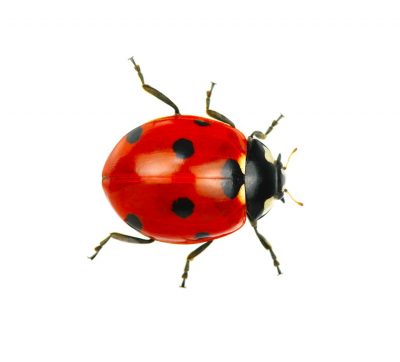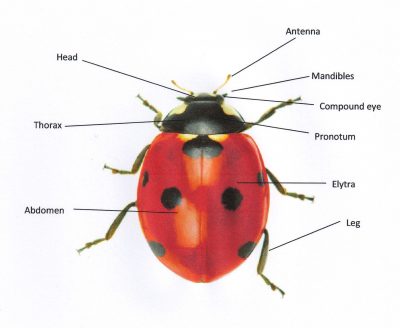Ladybirds


Ladybirds
Anatomy
Ladybirds are beetles. Their scientific name is coccinellidae, which means ‘little red sphere’.
They smell with their feet and antennae. They have two eyes but can only see in black and white. They are able to distinguish between light and dark. A ladybirds jaw moves sideways when it chews, not up and down like humans.
All ladybirds have wings. They are hidden under the shiny hard wing cases called the elytra. The elytra are hinged to the pronotum, the section just behind the ladybug’s head. When the ladybug flies, the elytra lift up, releasing the gossamer wings underneath, which beat eighty-five times a second. The wings fold neatly back under the elytra when the ladybird lands.
This hard exoskeleton prevents them from growing any larger and protects them from predators. The spots on the elytra fade as they get older. The spots are always symmetrical. However, not all ladybirds have spots, some are plain others are striped.
A ladybird can retract it head under the pronotum, which acts like a crash helmet, protecting the ladybug’s head from predators, giving it a more rounded appearance. Sometimes the pronotum has spots on as well.
Habitat
Ladybirds are solitary creatures preferring to live alone in vegetation. They can be found in forests, fields and gardens.
Farmers often have ladybird farms to help control pests on their crops.
Diet
Ladybirds eat aphids, such as greenfly and black fly, which helps the farmers’ crops and protects gardens. A few species will eat plants and mildew. They clean themselves after eating. If food is scarce ladybirds will eat each other and their own larvae.
Small birds, dragonflies, wasps, frogs and spiders eat ladybirds.
Lifecycle
The ladybird lifecycle has four stages: egg, larvae, pupa and adult.
The adult will lay about 10-15 eggs on the back of a leaf. These eggs look like tiny spots of yellow gel. A ladybird can lay up to 1000 eggs in its lifetime.
Ladybird larvae look like tiny lizards and shed their skin as they grow. They eat the infertile eggs and aphids before attaching themselves to a leaf for the pupa stage. The pupae are more rounded in shape. After about a week, the skin splits open and the fully grown ladybird emerges. At first they are very pale. It takes a few hours for the shell to harden and become bright red.
The whole process takes about a month. Females are bigger than the males. Their life expectancy is dependent on weather conditions.
Behaviour
Ladybirds hibernate in colonies in winter to keep warm. They are very slow fliers compared to other insects. Their fastest speed is about 15mph.
Its bright colours warn predators to stay away. They release a horrible smelling yellow liquid from their knees which is toxic to small birds and other predators.
Different species
It is not possible to tell a ladybirds age by counting the spots. The spots indicate the different species of ladybird. There are over 5000 different species of ladybird worldwide.
There are lots of different colour ladybirds, not only the common scarlet with black spots, black head, legs and antennae. You can also find orange with black spots, yellow with black spots, black with red spots and grey with white spots, striped or totally brown ladybirds.
